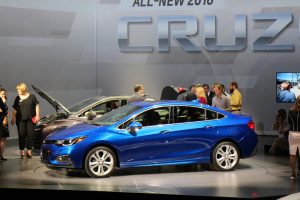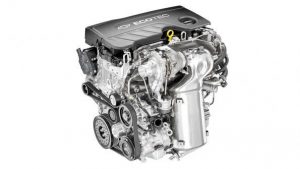We’re told the 2018 Chevy Cruze diesel will be capable of 52 MPG on the highway. But read the fine print.
And then the bold print.
Yes, the car will be capable of 52 MPG on the highway . . . if you order it with the six-speed manual transmission. With the automatic, the number drops by 5 MPG, to 47 MPG.
That’s a helluva drop.
It’s also a helluva problem – as most people will probably want the automatic, but be lured in by the media’s 52 MPG tub-thumping (and failure to mention the manual transmission fine print).
It’s weird, too, that the automatic is so much less efficient than the manual. In these latter days, it is usually the reverse: A given car with an automatic is generally more economical to drive than the same car with a manual, chiefly because modern automatics can out-shift a human-shifted manual and (typically) have a gearing advantage.
Which the Chevy’s automatic ought to have, it being a nine-speed automatic (vs. the manual six speed).
What is wrong with this picture?
Why is GM’s new nine-speed automatic so inefficient?
And then there’s the bold print – the 2018 Cruze diesel’s window sticker MSRP: $24,670.
That number gives us a handle on the cost of Uncle – how much Chevy has to spend to make the diesel Cruze EPA-compliant, plus a profit margin.
The cross-reference here is the formerly available but Uncle-outlawed VW Jetta TDI. It stickered for just under $22k.
Which was several thousand dollars less than a hybrid like the Prius.
That made it an economical alternative to a hybrid like the Prius – which not only cost a couple thousand bucks more but didn’t give you significantly better (enough to make up the difference) mileage.
But the Cruze diesel costs almost exactly as much as the Prius ($24,685; so $15 more than the Chevy) which means that in order to be an economical alternative to the Prius, the Cruze diesel would need to give significantly better mileage than the Prius.
It doesn’t.
If, that is, the major motivator is saving money on fuel. If it is some other reason, okay . . . but then we are having a different discussion.
The Jetta TDI that got fatwa’d out of existence delivered about the same MPGs as the numbers being touted for the Cruze.
But the Chevy is priced about $2,700 more to start than the VW was.
That’s the “TDI Tax” – the cost you’ll pay to buy an Uncle-approved diesel. Which just happens to be a GM diesel.
Interesting.
It’s hard to put a number on the cost of not being able to by a diesel such as those VW used to sell. Which – for awhile – were much cheaper to buy and also simpler, as a diesel engine ought to be.
It’s not just the MPGs that matter – or appeal – to diesel clientele. Lower operating costs, especially lower maintenance costs, were also a major factor.
“Were” italicized with reason.
The Cruze and other Uncle-approved diesels are not simple. They all have DEF tanks and DEF injection. You should know about this before you rush off to the dealership. DEF is Diesel Exhaust Fluid – which is urea, which is (basically) “number 1” sprayed into the exhaust stream to modify the resultant exhaust product to a more Uncle-approved perfume.
The DEF must be topped off periodically – or the car’s all-controlling computer will shut the works down, Barter Town-style, if you fail to do so. Figure about $20 or so every three months, give or take. It’s not a huge sum, but it’s not free – and it is a hassle.
Even if you do faithfully keep the DEF tank topped off, the injection system (and the rest of the exhaust system) is even more complicated than a gas-engined car’s, with its multiple catalytic converters and oxygen (O2) sensors.
More complicated always means – more expensive. More things that could go wrong means more things that will go wrong. It’s inevitable. The press kit automotive press rarely brings such things up.
It is an axiom of engineering that simpler is better – if the object is to avoid downtime for repairs.
And the expense of repairs.
Simpler is arguably why the Russians beat the Germans in World War II; the Russians’ equipment was less prone to not-working at a critical moment than the Germans’ often-technically brilliant but also breakdown prone stuff, such as the King Tiger and Jagdtiger tank destroyer.
The same goes for the fuel delivery system of modern diesels – which is no longer a simple mechanical system but instead a very elaborate electronic one, not unlike the direct injection systems used in gas engines.
And then there’s the fuel.
It used to be less refined and so – cost less.
Today, it is refined more in order to be Ultra Low Sulfur and so costs more.
Forget using homebrew – biodiesel or anything that cost less. It’ll gum up the plumbing as well as void the warranty.
So what’s the reason for all the positive press about the ’18 Cruze diesel?
Can anyone explain why it would make economic sense to buy one? What is the “ROI” – the Return on Investment that GM is constantly mantra’ing about? 
Gas engines have not only almost caught up with diesels on the mileage front (40 MPG on the highway now being fairly common) they are also catching up to the torque numbers produced by diesel engines, because of the widespread use of turbochargers.
For instance: The Cruze’s standard (and tiny) 1.4 liter gas engine makes 177 ft.-lbs. of torque at just 2,000 RPM. Very diesel-like – as is the mileage: 30 city, 40 on the highway. But the gas turbo Cruze lists for just $16,975 – a difference of $7,695 vs. the MSRP of the diesel Cruze.
Would you pay almost $8k more for 12 MPG better on the highway and maybe 8 MPG better overall? Not counting the higher per-gallon cost of diesel vs. gas? Plus the hassle of the DEF tank?
Either I’m high . . . or everyone else is.
If you like what you’ve found here, please consider supporting EPautos.
We depend on you to keep the wheels turning!
Our donate button is here.
If you prefer not to use PayPal, our mailing address is:
EPautos
721 Hummingbird Lane SE
Copper Hill, VA 24079
PS: EPautos magnets are free to those who send in $20 or more to support the site. Please bear with as I have had to order a new batch; they should be here – and in the mail – within a couple weeks. 













Just get the gas powered one. I have the 2016 Premier with the 1.4L Turbo Direct Injection. If I only drive 55-60 MPH I have gotten 47.7 MPG as a best. My normal 75-80 MPH yields about 30 MPG. Mine is loaded and I have the GM Employee discount and came in at $27K. Should have gotten the Volt, but that is a different story.
Manual transmissions are always going to be more efficient on the highway. No amount of computers and dual clutch gearboxes and speeds in an auto will fix the issue of the thing being so damn heavy and loosing power to fluid, at least on the highway. There are some things modern computers can’t beat, and it’s brats that refuse to drive one simply because they’re lazy that have the problem. It’s not a problem for those of us willing to work for our money. It gets higher mpg because one is a slushbox and one has a clutch. It’s the nature of the beast not any kind of inefficient design. You cant make an auto better than a properly designed manual on the highway. Less parasitic loss and less weight, its just that simple. There is no fine print y’all are just lazy.
VW couldn’t do it. Mazda decided not to try. However we’re supposed to believe that GM was somehow able to produce an EPA compliant small diesel engine? Are these MAGIC diesel engines?
Hi Fack,
I absolutely believe they produced it. But I wonder about its real-world mileage and long-term durability… and I know about its cost.
The only way the engines can comply with the idiotic EPA requirements is to have the DEF. The VW’s didn’t.
Diesel engines in the construction industry have all skyrocketed in cost–the car industry is significant also– because of the development costs of tier 4 final engines. The cost of tier 4 is astronomical for the United States, all for a minuscule reduction of tenths of a percent of “harmful emissions”. It’s a fking load of shit.
It shouldn’t be a surprise. GM is gigantic and has the USG behind it.
They are using the US market to test their exhaust output enhancements before sending them over to Western Europe where rules will soon force old diesels be retired. Europe at least has a diesel car market of size.
In different regions of the country, the cost of the fuel alone can make the venture risky.
Diesel can often be higher in cost than Premium, especially in the Northeast where its feedstock has competing for it the needs of those looking to heat their homes and businesses in the dead of winter. Also, winter blend Diesel is potentially more costly as standard No2 Diesel is cut with Kerosene at up to 50%.
You’re exaggerating the recurring cost on the DEF. Don’t use the auto-parts store or dealership rate as a guide. It’s reasonably easy to get DEF at the local Pilot/Flying J for less than $3/gal. Every 6k or so on my 2014 Cruze Diesel, I fill up, and it costs around $12 or so, the tank’s capacity is around 5 gallons, and I get a reading on the DEF level when I’m down around one gallon or so.
Not just that, Eric, but I’ll bet in the real world, the li’l Gov’t Motors cheese car doesn’t get the 47MPGs, and knowing GM, that diesel will be extremely short-lived. I mean, sheesh, they can hardly make a gas engine that’ll keep a head gasket…..
There’s an EPA livestream in an hour. Hopefully they layoff all 15k bureau rats and its $8 billion budget.
http://www.fedsmith.com/2017/02/20/restoring-epa-priorities-and-involving-federal-employees/
Pruitt’s “Welcome”
https://www.epa.gov/
It is not uncommon that even with a modern double clutch automatic gearbox, the automatic will, ideally speaking, use from 5 – 10 % more fuel that an equivalent car with the corresponding manual transmission. When I say “ideally speaking”, this means that most people will not succeed in gearing optimally with a manual transmission. They will most of the time keep a too high RPM, when gearing manually and thus use more fuel that the minimum possible.
On the other hand an automatic gearbox will change the gears optimally for you and it will keep the RPM as low as possible to save fuel. In practice the automatic gearbox will still achieve a better mileage that the manual gearbox. A friend of min who always complained about terrible mileage; more that 50 % above what the car manufacturer indicated, was always driving with a far too high RPM, and thus wasting a lot of fuel for no good reason at all.
When my friend was allowed to test a car with automatic gearing, he was astonished by how little fuel he suddenly used. Why? Because the automatic geared much more optimally that he was able to, thus saving a lot of fuel for him.
I’ve always questioned the “official” wisdom in all that gearing and rpm. In my real world experience. A 1990 mustang with 2.73 gears, I got significantly better mileage when I switch to 3.73 gears. From what I could tell the 2.73 was too hard on the engine at 60mph. Any sort of hill would require a down shift.
My other car was a 1994 integra gsr which I built a turbo setup and tuned myself. It made over 265whp and would get 38 mpg average with half highway commute and plenty of full throttle runs. It worked great and I always wondered why Honda could not do better?
As a Norwegian I do not know much about the generally powerful american cars. Generally speaking, I still think that we can agree that it is a challenge to drive cars with a “long” gearing as economically as possible. One has to gear up and down more often, if the gearing is too “long”. It is obviously tempting then to not use the top gear(s) so often.
Automatic transmission doesn’t get tired of gearing up and down all the time, so an automatic can help you to shift gears more optimally and save some fuel, even if it on paper may use somewhat more fuel than manual transmission. As mentioned, it it difficult for the driver to actually use a manual gearbox optimally.
> the Russians’ equipment was less prone to not-working at a critical moment than the Germans’ often-technically brilliant but also breakdown prone stuff
Off topic here, but there’s been some recent research that says that the US tanks broke down about as often as the German ones. But because they could be easily repaired, the mission availability was better. Get a broken Sherman in at 5pm, it could have a new transmission put in overnight and be ready to go in the morning. (logistics wins wars)
Chip H.
Hi Chip,
Yup – I’ve read about that, too.
The Germans were infamous for complex equipment and also too many types of equipment; it was a “force multiplier” … in reverse!
The Soviets won the war with the T-34 not due to any inherent ‘reliability’ but, with American ‘Lend-Lease’ supplying them with medical supplies, food, radios, telephones, Dodge and Studebaker trucks, and enough leather to shod the entire Red Army twice over, they could focus their war economy on weapons production, including crap loads of T-34s. Since, as Stalin put it, “Quantity has a ‘quality’ all its own”, even knowing the type’s deficiencies and having an improved medium tank design (T-43) available, they chose to produce it and developed the T-34/85, which used the T-43’s three-man turret with the more effective 85 mm gun. This beast was likely the epitome of ‘bang for the buck’ in tank design.
But ultimately it was just the large number of Sherman tanks that made it work.
There’s no question the Sherman was outclassed towards the end of the war. The armor was too thin and it was under-gunned compared to the German tanks.
When I was in Belgium last year, they have one on display at the Mardasson Museum. There’s a shell hole that goes through one side of the body and nearly out the other side (almost a through-and-through). Doubtful that the crew survived that.
Chip H.
It’s gotten to the point that the only legitimate reason to buy a diesel is for heavy towing. That’s the only reason to put up with the ridiculous emission systems. I love diesels and have owned several, but went back to a gasser when I downsized trailer. I think Ford, Chevy and Ram are still willing to screw around with diesel in their cars and half tons to nuance their CAFEs a little. Maybe the new administration will reign in this crazy war on diesel.
Hi Wikoli,
Indeed… I’d have bought a pre-scandal VW TDI. I would not buy one of these Uncle-approved versions. For all the reasons mentioned.
GM/Barra’s mantra is “ROI.” Ok, what’s the ROI on this thing for the buyer?
It requires a specific use case.
The buyer must intend to use the vehicle for many more miles than a typical lease would allow. I’d say north of 40kmi/yr.
Hi Warp,
The really sad thing is that – absent the insane EPA fatwas – and the none-of-their-damn business NHTSA “safety” fatwas – we could have 80-plus MPG diesels that cost $15k, brand new.
You’re not including the potential for diesel-electric hybrids in that estimate. Those would probably get north of 150 mpg and not look like nerd boxes like the Prii.
Hi Wikoli,
Also: The difference in mileage, gas vs. diesel, is no longer that great – and with gas as cheap as it is right now, unless you need to tow, I can’t come up with a good reason to buy a diesel.
The other advantages of diesels- i.e simplicity, reliability, and durability, which once upon a time made them so desirable, are all gone now, with these modern electronically-controlled, oil-fired injector horse-piss-emission-strangled “diesels”.
So like you say, Eric, except for towing power, there’s really no advantage to these modern diesels.
Those high-efficiency/high-compression direct injection gasoline engines come at a cost.
The coking on them looks brutal.
GM tries diesel cars again…. Yeah, this should end well…..
Morning, Nunzio!
If this thing hit 60 MPG, then maybe.
But 52? (47, really, for most people)… what’s the big whoop?
There are several cars in this class that are in the high 30s/low 40s – and cost a few thousand less.
Unless gas becomes significantly more expensive than diesel, I don’t see how the maff adds up…
I am guessing it’s heavier then it needs to be too.